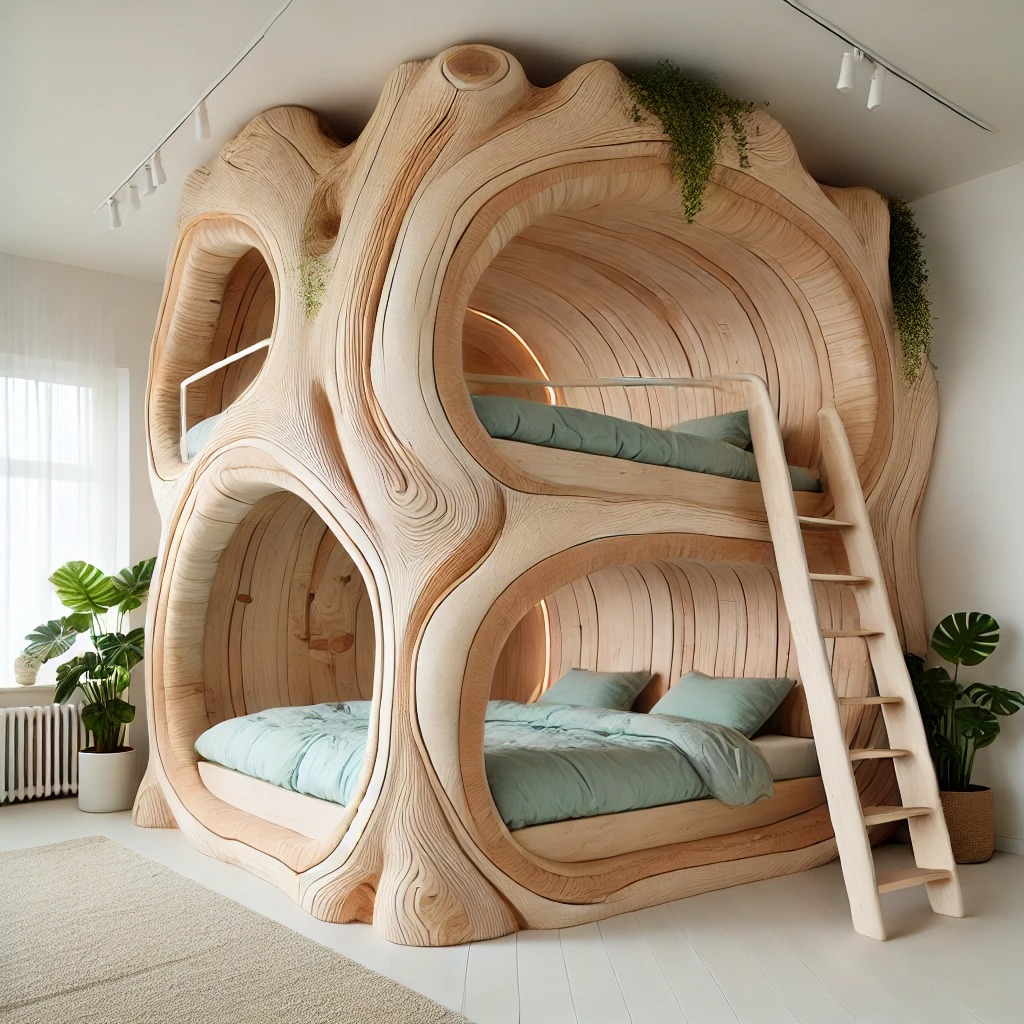
The charm of a tree trunk bunk bed brings the beauty of nature into your home, creating an inviting and cozy atmosphere. This unique piece of furniture not only serves as a functional sleeping solution for multiple individuals but also acts as a stunning centerpiece that embodies rustic elegance. The organic textures and natural hues of a tree trunk make it a versatile addition to various design themes, from traditional cabins to contemporary homes. In this article, we will explore the many facets of the tree trunk bunk bed, examining its design, construction, benefits, and maintenance.
- Related post: Submarine Aquarium Bed
Contents
Design Aspects of a Tree Trunk Bunk Bed
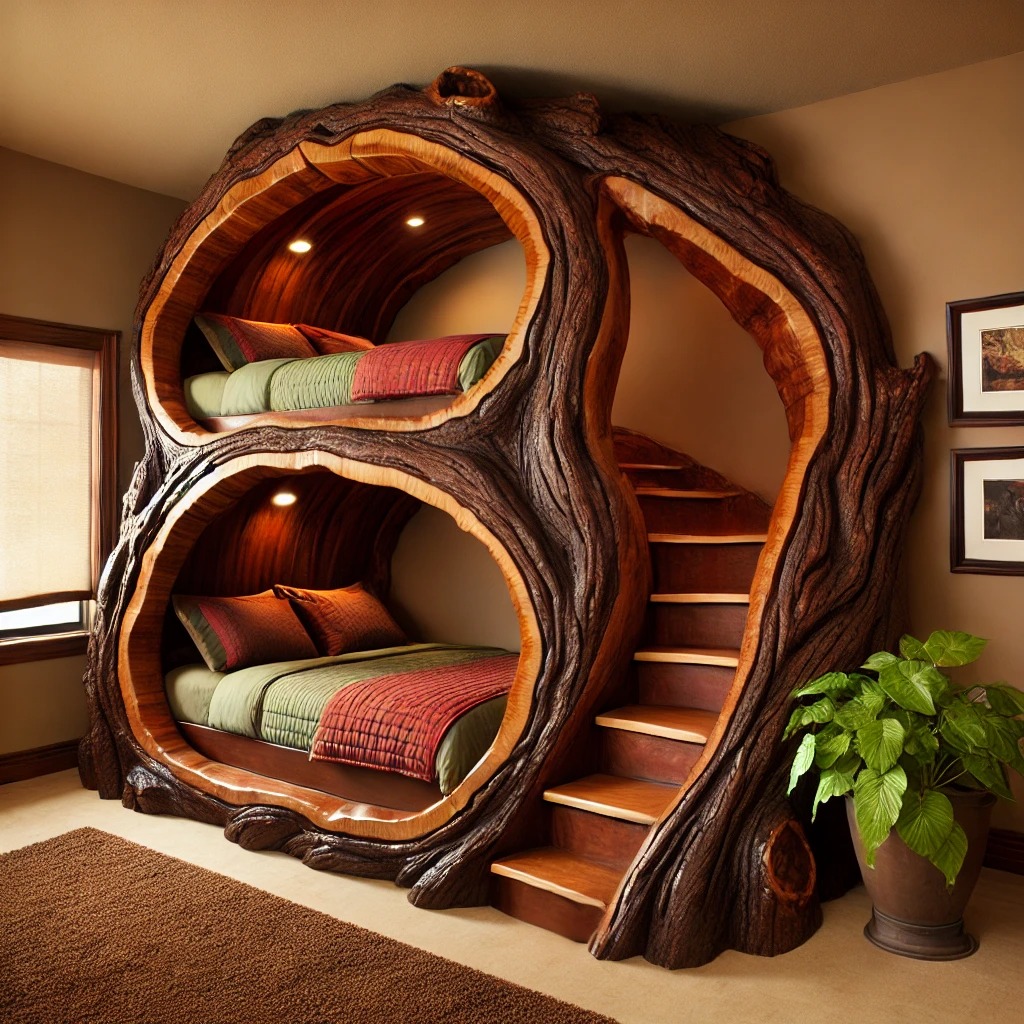
Design plays a crucial role in establishing the aesthetic appeal of any piece of furniture. A tree trunk bunk bed is no exception; it combines practicality with artistic flair.
Embracing Natural Elements
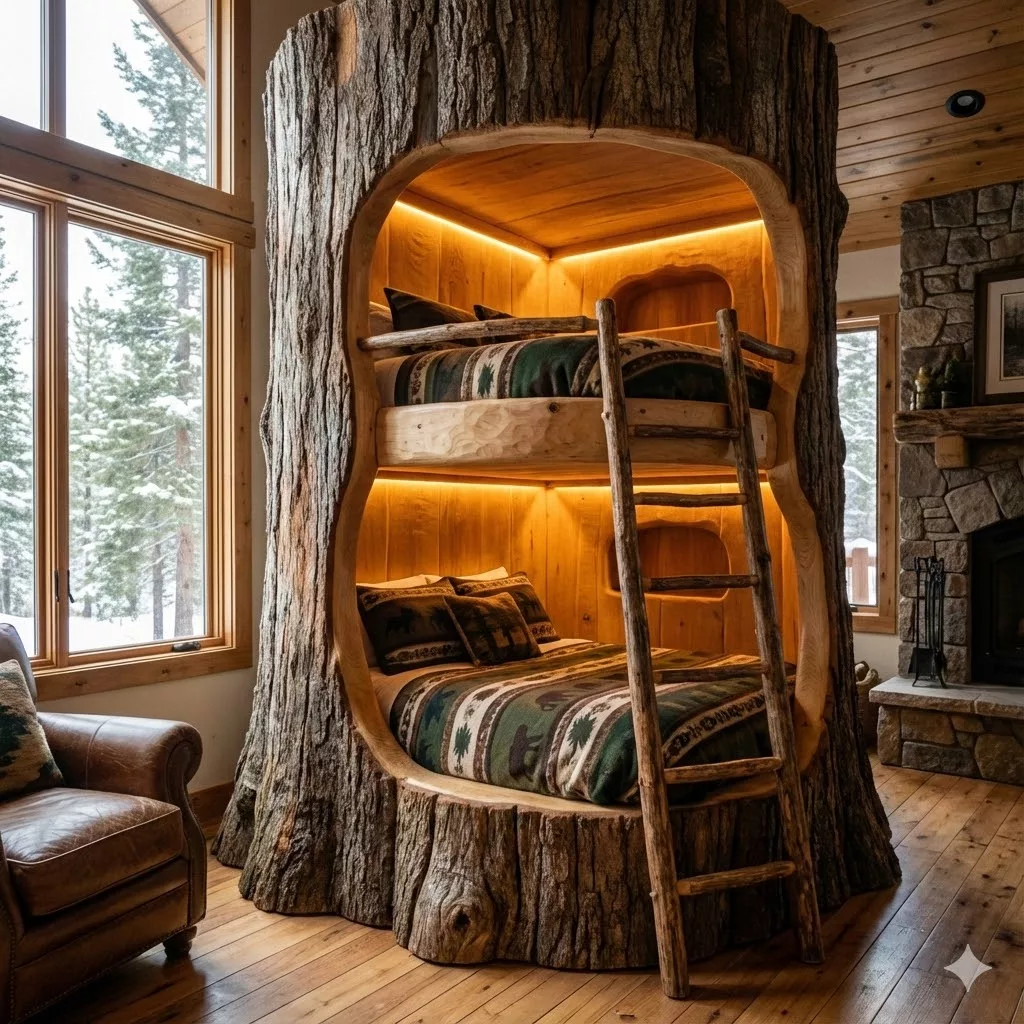
Incorporating natural elements into interior design has become increasingly popular in recent years. A tree trunk bunk bed embraces this trend by showcasing raw wood’s beauty and character.
Natural wood exudes warmth and authenticity that manufactured materials often lack. Every tree trunk is unique, featuring its distinct grain patterns, knots, and imperfections that tell a story. When crafted into a bunk bed, these characteristics create a one-of-a-kind piece that can fit seamlessly into any room.
Furthermore, natural wood promotes a sense of tranquility. The organic look and feel of a tree trunk can evoke feelings of comfort and relaxation. When children see a bunk bed made from real wood, they may feel more connected to nature, which can enhance their playtime and sleep experience.
Customization Options
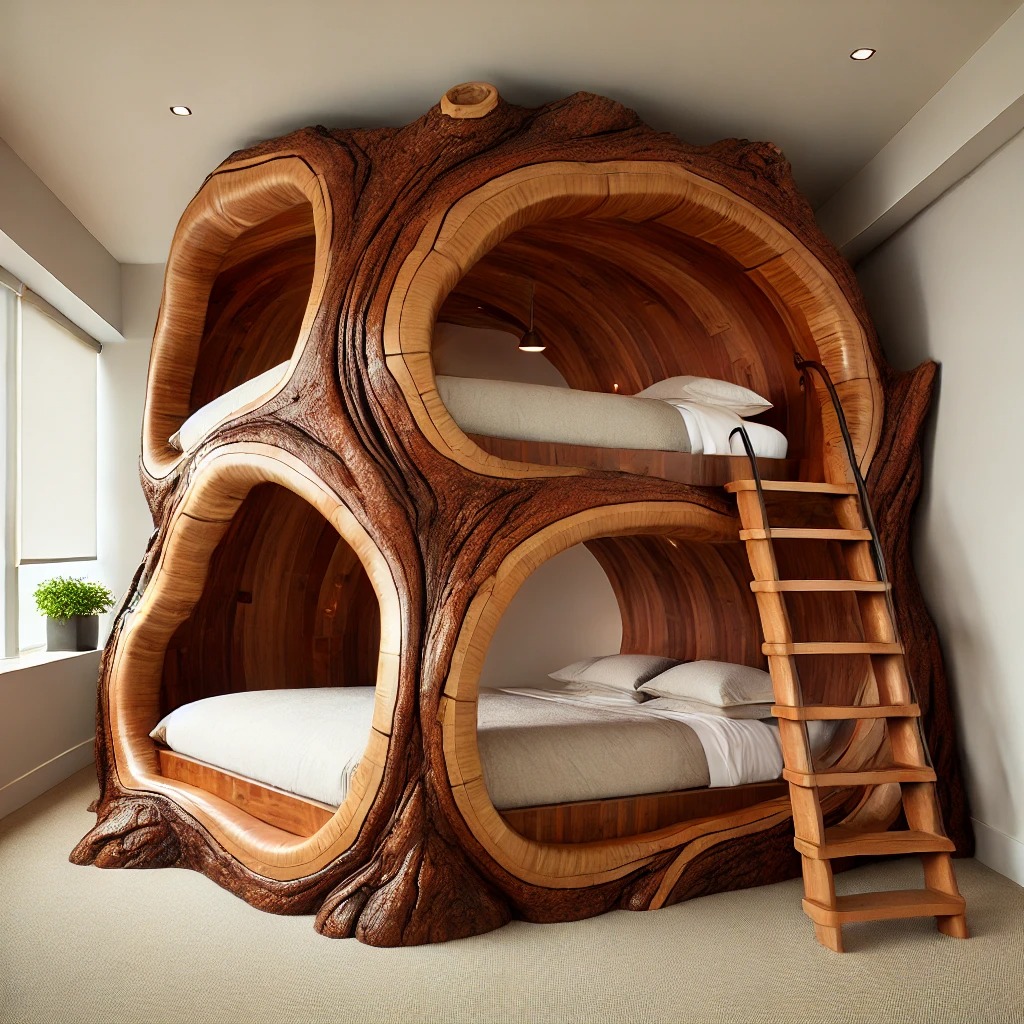
One of the most appealing aspects of a tree trunk bunk bed is the potential for customization. Homeowners can choose different types of wood, finishes, and styles to match their existing decor.
The choice of wood species can significantly alter the look of the bunk bed. For instance, oak provides durability and a classic appearance, while pine offers a lighter touch that creates a more whimsical vibe. Additionally, stains and finishes can be applied to accentuate the wood grain or provide a pop of color.
Custom designs can also include additional features such as built-in storage, ladders, or even slide attachments for added fun. These personalized touches not only enhance the functionality of the bunk bed but also allow it to reflect the homeowner’s personality and taste.
Space-Saving Solutions
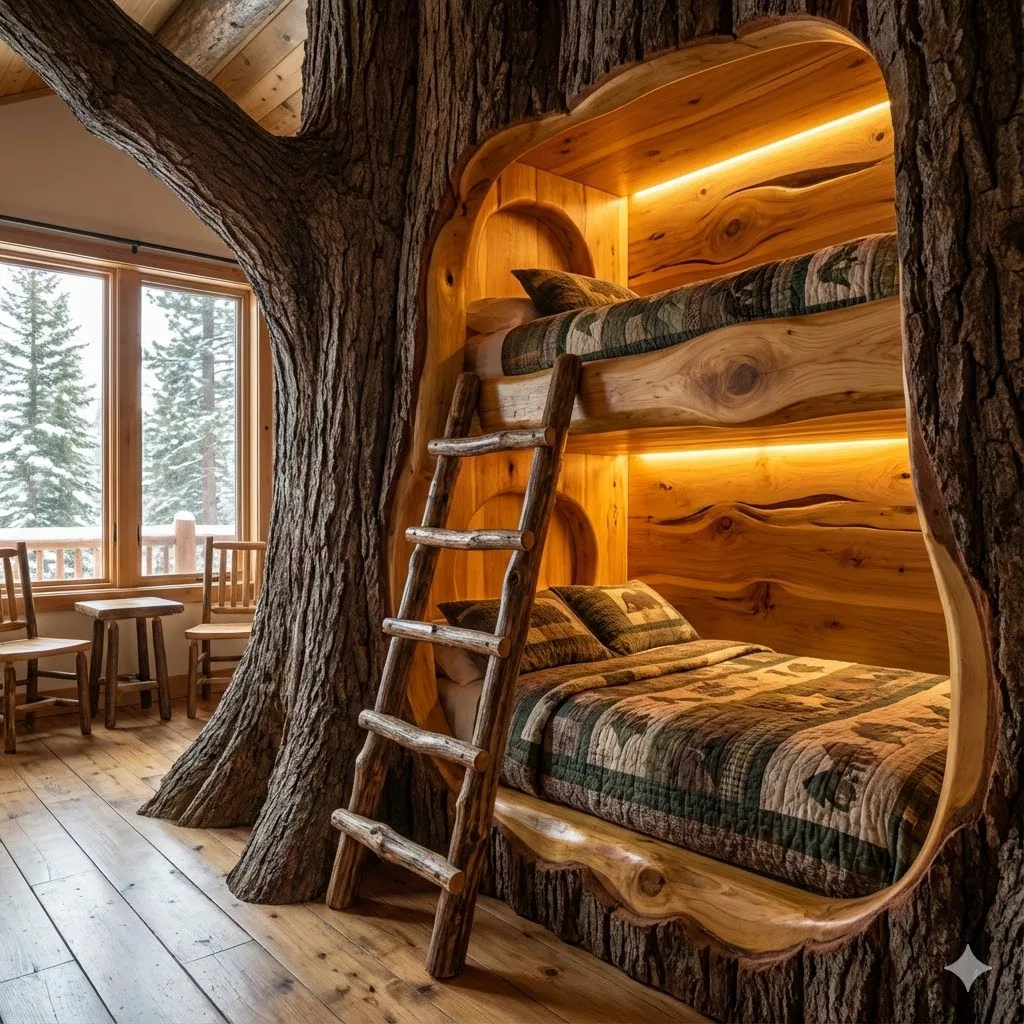
A tree trunk bunk bed is an excellent space-saving solution, particularly for smaller rooms.
By stacking two beds vertically, families can maximize floor space while still providing comfortable sleeping arrangements. This design allows for more room for play or other furniture, making it ideal for children’s bedrooms or guest accommodations.
Moreover, bunk beds can also come with creative storage solutions beneath the lower bed. This setup can help keep spaces organized and clutter-free.
Families can utilize the area under the lower bunk for toy storage, bookshelves, or even a small desk—a practical approach that takes advantage of every square inch.
Construction and Materials Used in Tree Trunk Bunk Beds
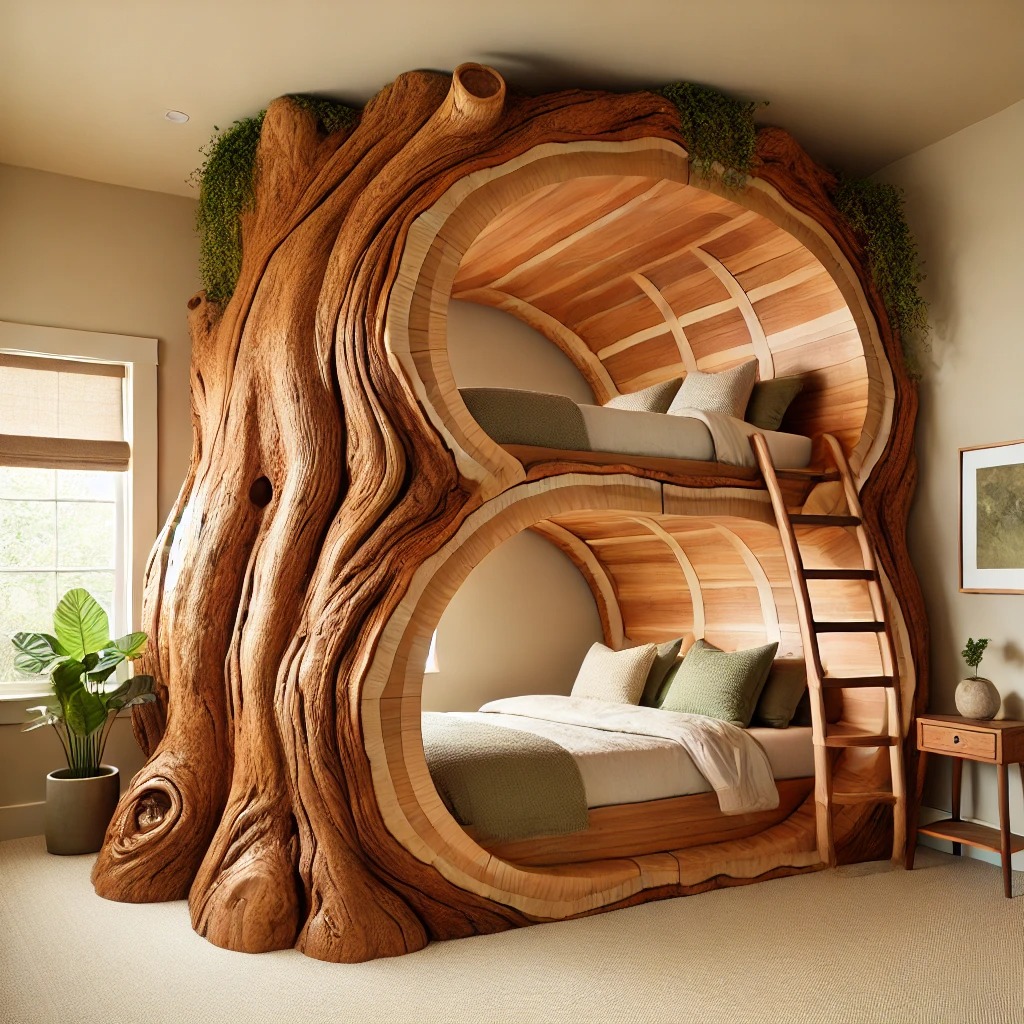
The materials used in crafting a tree trunk bunk bed are paramount to its overall quality, durability, and safety.
Selecting the Right Wood
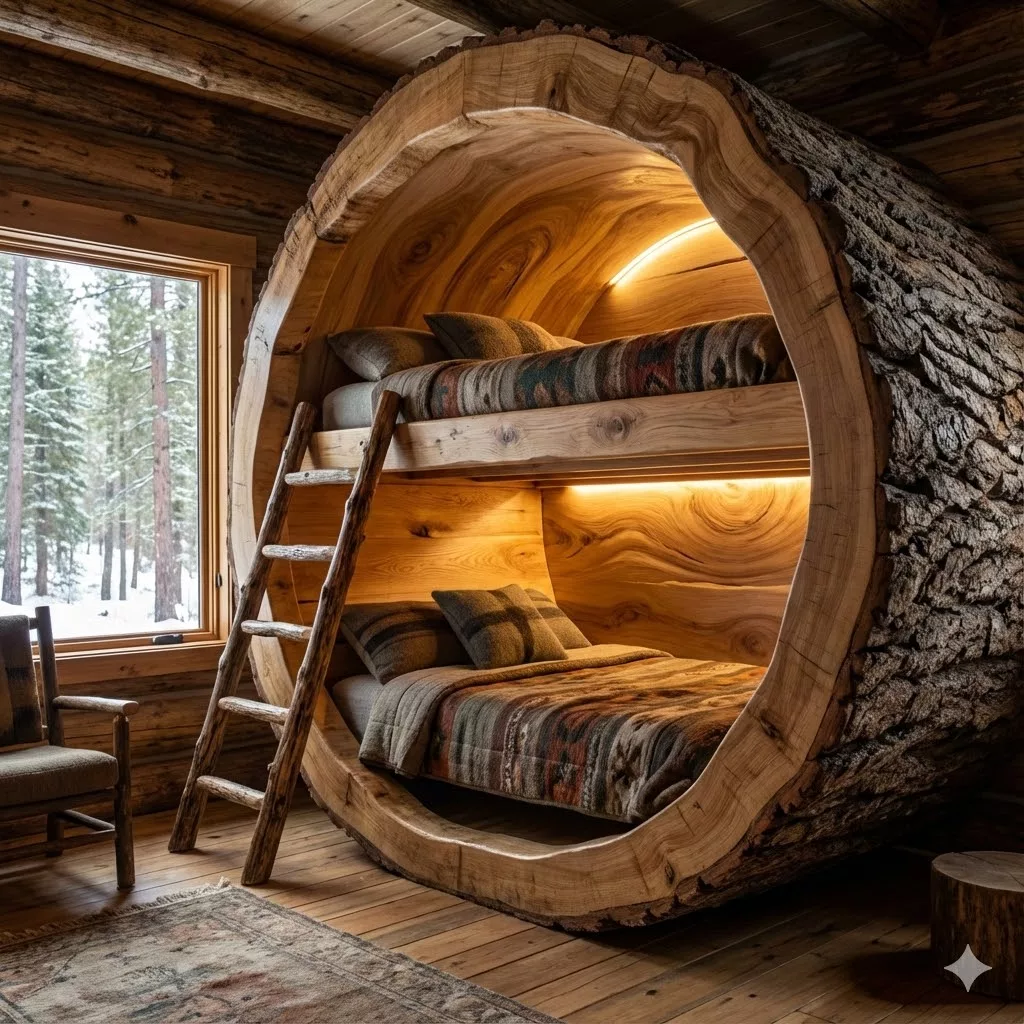
Choosing the right type of wood is essential when constructing a sturdy tree trunk bunk bed.
Common choices include hardwoods like oak and maple for their strength and longevity. These woods can withstand wear and tear over time, making them perfect for high-traffic areas like children’s rooms.
Softwoods like pine are also popular due to their lighter weight and ease of handling. Although softer, they can still provide adequate support if constructed correctly.
Ultimately, the choice of wood will depend on the desired aesthetic and intended use of the bunk bed.
Craftsmanship and Techniques

The craftsmanship involved in building a tree trunk bunk bed can significantly impact its quality and stability.
Artisans typically use traditional woodworking techniques, ensuring that each joint is secure and well-fitted. Mortise and tenon joints are commonly employed due to their strength and durability.
Natural finishes, such as oil or beeswax, are often used to protect the wood while highlighting its natural beauty. These finishes not only enhance the wood’s aesthetic appeal but also create a protective barrier against moisture and daily wear.
Additionally, some manufacturers opt for eco-friendly adhesives and sealants to ensure that the final product is safe for children and environmentally conscious.
Safety Considerations
Safety is a top priority when constructing a tree trunk bunk bed, especially for children’s use.
Ensuring that the structure is stable and securely anchored is crucial. Many modern designs incorporate safety rails on the upper bunk to prevent accidental falls during the night.
It is also essential to comply with safety standards set by organizations such as the Consumer Product Safety Commission (CPSC). These guidelines outline requirements for bunk bed design, including guardrail height and mattress size, to ensure child safety.
Regular maintenance checks should be conducted to ensure that all components remain secure and in good condition over time.
Benefits of Choosing a Tree Trunk Bunk Bed
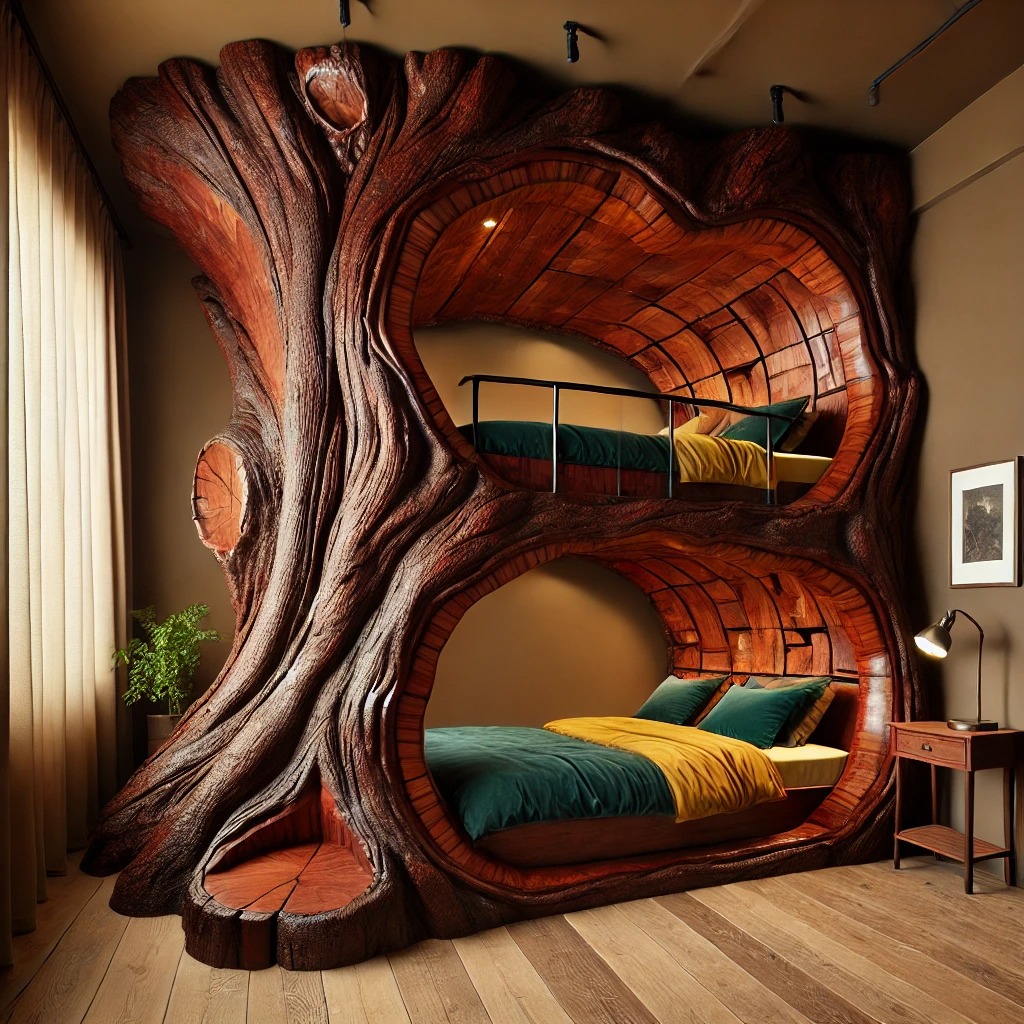
Opting for a tree trunk bunk bed comes with numerous advantages that extend beyond aesthetic appeal.
Eco-Friendly Choice
As awareness of environmental issues continues to grow, many homeowners are seeking sustainable alternatives for their furnishings.
A tree trunk bunk bed can be an eco-friendly choice, especially when sourced from responsibly managed forests. Sustainable wood products reduce the carbon footprint associated with furniture production and encourage responsible forestry practices.
Additionally, the durability of wood means that the bunk bed can last for generations, further minimizing waste and the need for frequent replacements.
Enhancing Creativity and Imagination
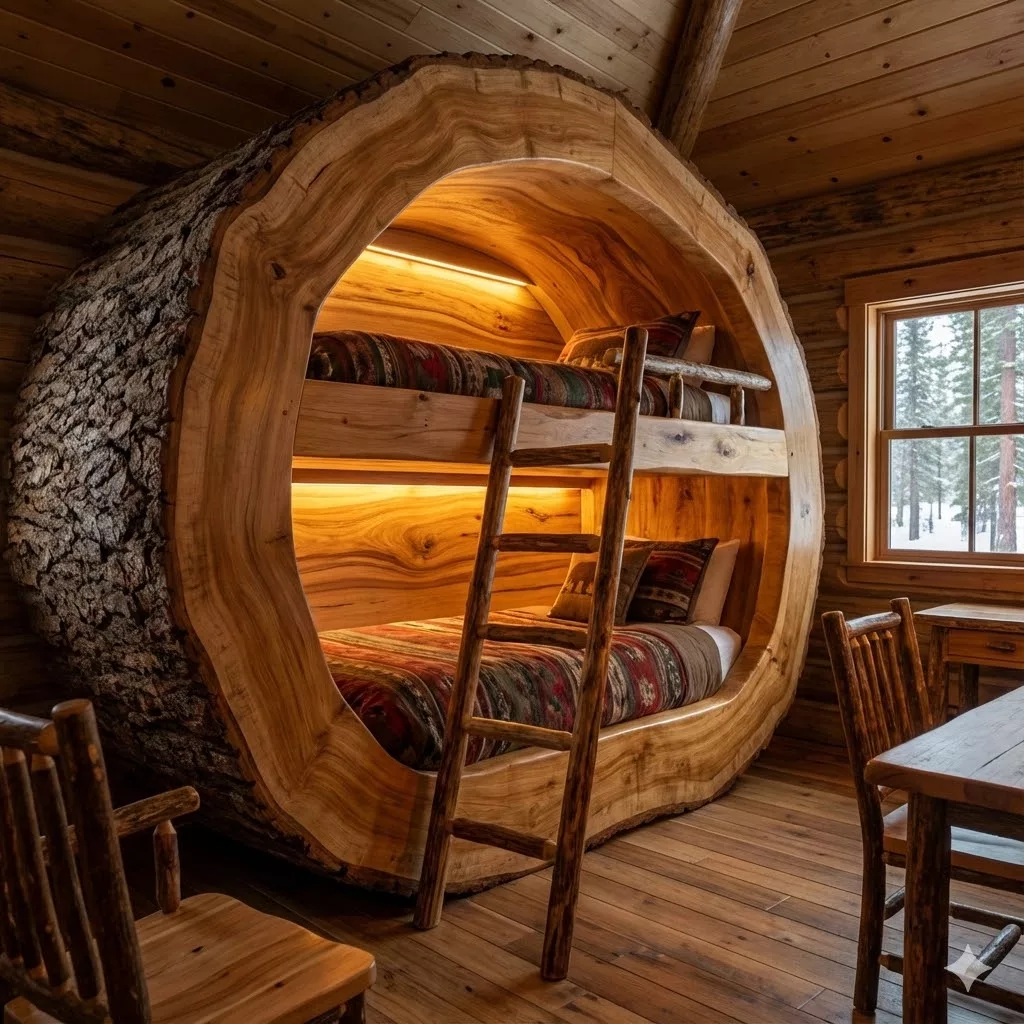
Children thrive in environments that stimulate their creativity and imagination.
A tree trunk bunk bed can serve as a fantastic backdrop for imaginative play. Kids can turn their bedtime story fantasies into reality, whether they’re camping in the woods or setting up a pirate ship adventure.
The rugged, natural aesthetics of the bunk bed can inspire countless hours of creative play. Parents can also encourage storytelling sessions or themed sleepovers that revolve around the enchanting experience offered by the tree trunk design.
Fostering Family Bonding
Bunk beds are often viewed as synonymous with shared experiences.
When siblings or friends share a bunk bed, they create memories together—late-night chats, giggles, and the occasional pillow fight. A tree trunk bunk bed can enhance that bond through its unique design, which invites interaction and encourages socialization.
Moreover, the communal aspect of sharing a space helps foster a sense of security and companionship among children. Families can spend time together reading stories at bedtime or playing games in the comfort of their rustic sanctuary.
Maintenance and Care for Your Tree Trunk Bunk Bed
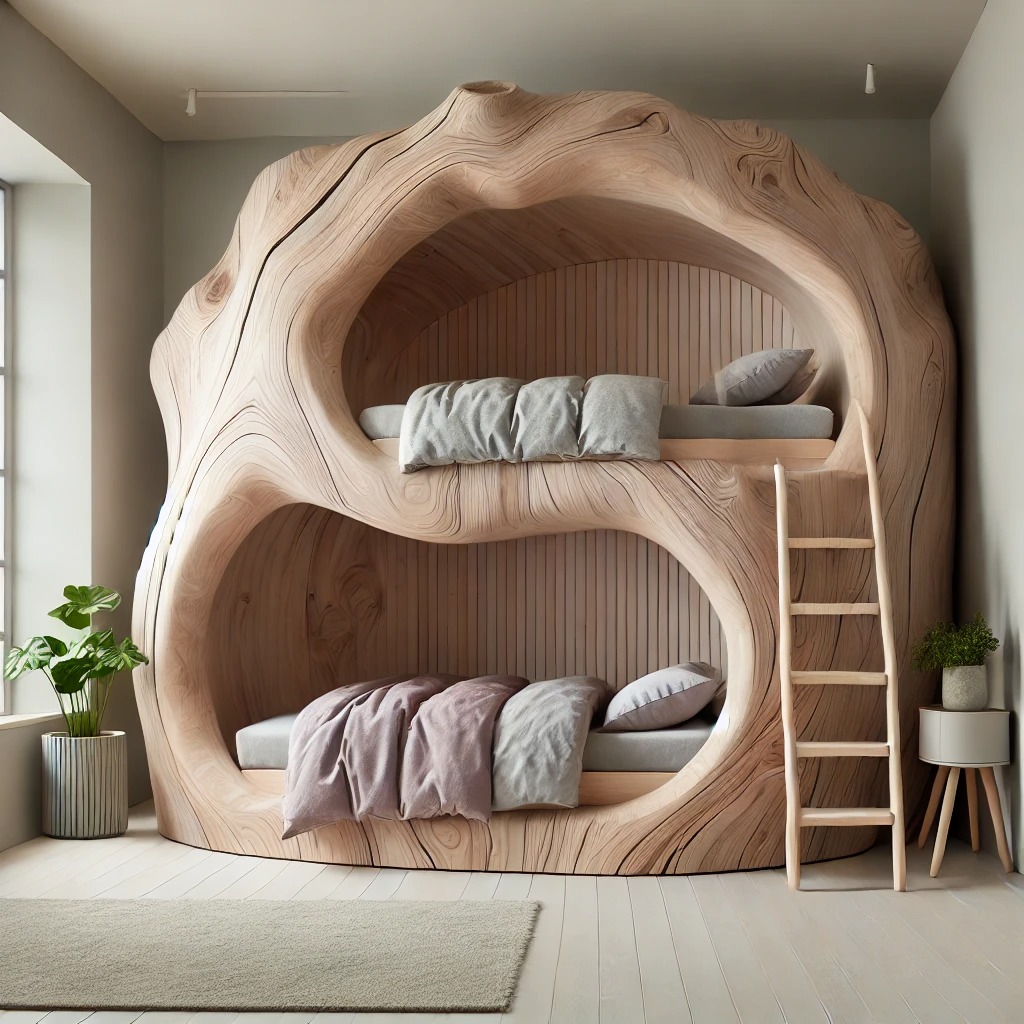
While a tree trunk bunk bed is built to last, proper maintenance is necessary to preserve its beauty and functionality.
Regular Cleaning Practices
Keeping your tree trunk bunk bed clean is essential for maintaining hygiene and prolonging its lifespan.
Dust can accumulate on the surface, so regular dusting with a soft cloth is recommended. Avoid using harsh cleaning agents, as they can damage the wood’s finish. A mild soap solution and water can be used sparingly to spot clean any stains.
For deeper cleaning, consider using a gentle wood cleaner designed specifically for treated surfaces. This will help remove buildup without harming the natural finish of the wood.
Inspecting for Damage
Over time, wear and tear may occur, especially in a children’s bedroom.
Regularly inspect the bunk bed for any signs of damage or instability. Look for loose joints, cracked wood, or splinters, which may require immediate attention. If you notice any issues, consult a professional carpenter for repairs to ensure the bed remains safe and secure.
Pay particular attention to the ladder and guardrails, as these areas are frequently used and may wear down quicker than others.
Reapplying Finishes
To maintain the beauty of your tree trunk bunk bed, it may be necessary to reapply protective finishes periodically.
Natural oils or waxes can rejuvenate the wood’s appearance while providing a layer of protection against moisture and wear. Depending on the environment and usage, maintenance can be performed annually or bi-annually.
Before applying any new finishes, ensure that the bed is clean and dry. Follow the manufacturer’s instructions for the best results.
Conclusion
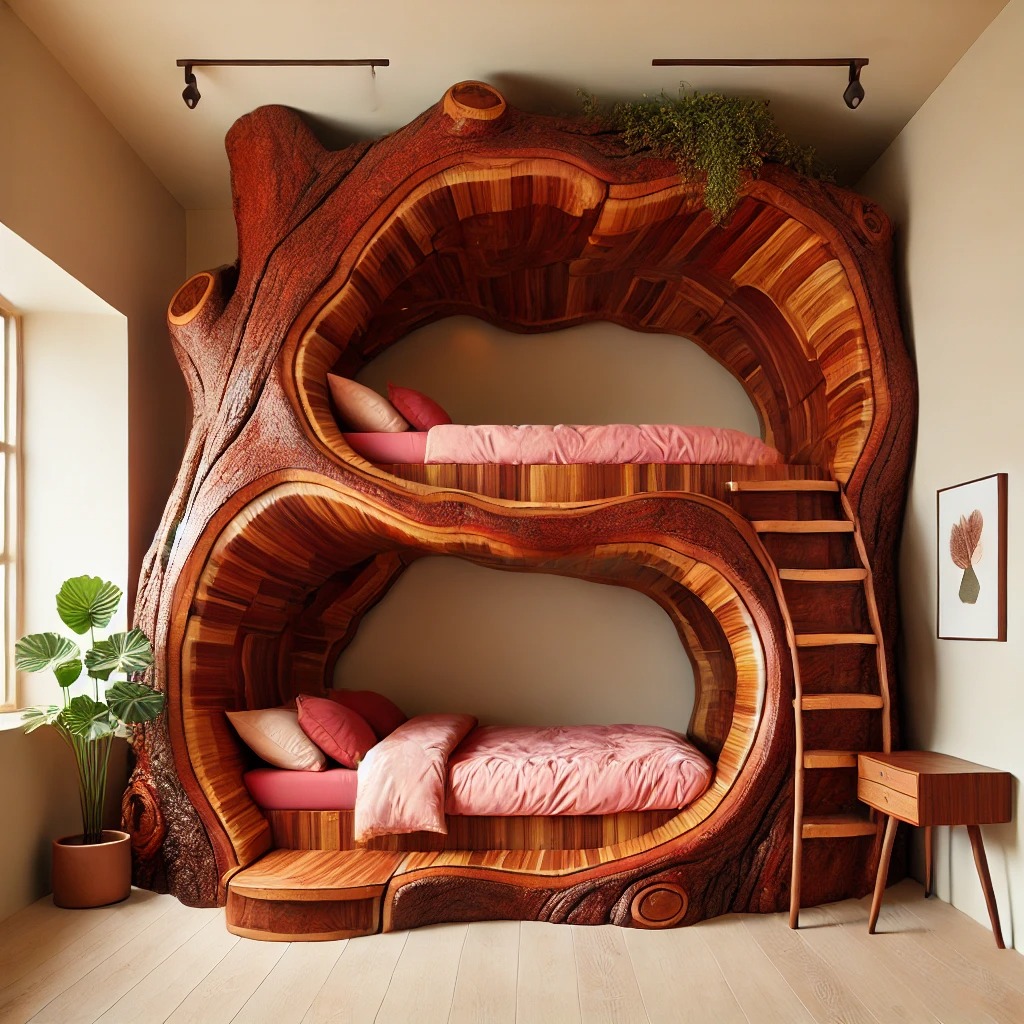
Investing in a rustic tree trunk bunk bed creates a warm and inviting atmosphere that enhances any living space, especially children’s bedrooms. With its unique design, strong construction, and numerous benefits, a tree trunk bunk bed stands out as a functional yet aesthetically pleasing piece of furniture. By embracing the beauty of natural wood, customizing the design to suit individual preferences, and prioritizing safety, families can create lasting memories in a charming and sustainable environment. Proper maintenance ensures that this wonderful addition to your home remains a cherished focal point for years to come.






